
Inspired by the ancient Japanese art of Origami, engineers at Harvard and MIT have developed an amazing robot that stats off as one single sheet, then folds itself into a complex shape in under four minutes, before making a gentleman’s exit. The potential applications of this display are numerous. For instance, launching payload in space is extremely expensive so any efforts to curve mass or volume are much sought after. Imagine satellites or robots that start off from an easy to transport shape, only to fold into desires geometries once deployed in orbit.
Self-assemble, then run!

This is the first demonstrated robot that builds itself and also performs a function, all without human intervention. To build it, the authors took inspiration from Origami and Shrinky Dinks (the classic children’s toy that shrinks a plastic-paper composite in a rigid form when heated). The whole electromechanical system is embedded in a single sheet, made using a solid ink printer, a laser machine, and the researchers’ hands.
“Getting a robot to assemble itself autonomously and actually perform a function has been a milestone we’ve been chasing for many years,” said senior authorRobert J. Wood, Charles River Professor of Engineering and Applied Sciences at the Harvard School of Engineering and Applied Sciences (SEAS) and a core faculty member at the Wyss Institute for Biologically Inspired Engineering at Harvard.
Atop the flat sheet, two motors, two batteries and a microcontroller that houses the robot’s brain were added. The sheet is comprised of multiple layers: paper, polystyrene (Shrinky Dinks!!!) and a flexible circuit board. The polystyrene sheets were mechanically programmed to fold at specific angles when subjected to specific temperatures produced by embedded circuits that light up on command by the microcontroller. After the polystyrene hinges cool, four minutes since the process first starts, these harden making the whole robot stiff. This is the robot’s cue to crawl away casually, at a lean speed of one-tenth of a mile per hour. The whole process goes through an energy expenditure equivalent to one AA alkaline battery. A trifle!
“You would be able to come in, describe what you need in fairly basic terms, and come back an hour later to get your robotic helper,” Wood said. All told, each robot cost about $100, but only $20 for the body without the motors, batteries, and microcontroller.
“This achievement by Rob and his team changes the way we think about manufacturing, in that the machine fabricates itself,” said Don Ingber, founding director of the Wyss Institute, Judah Folkman Professor of Vascular Biology at Harvard Medical School, and professor of bioengineering at Harvard SEAS. “The days of big, rigid, robots that sit in place and carry out the same repetitive task day in and out are fading fast.”
The robot was reported in a paper published in the journal Science.


